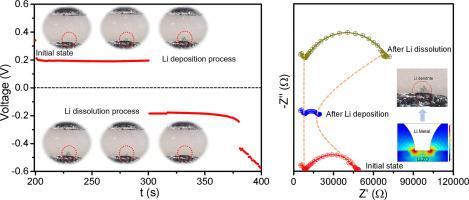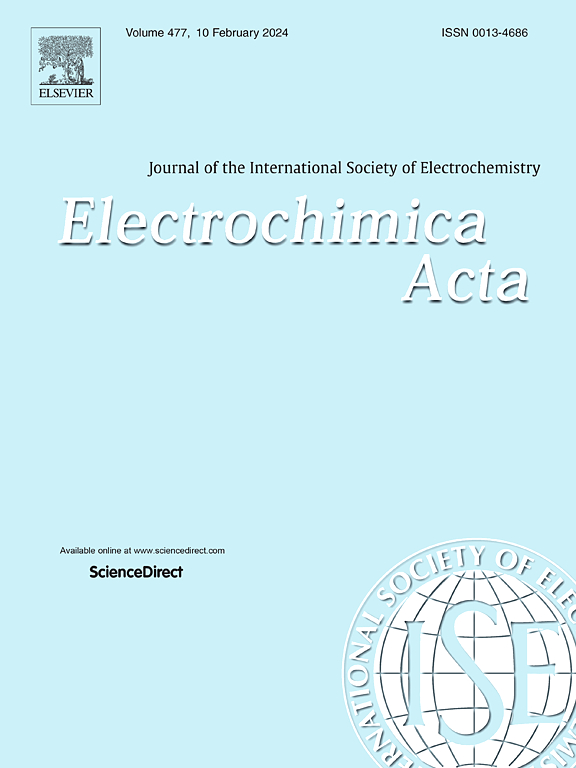Unveiling the mechanism of lithium dendrite infiltration into solid state electrolyte through the coupling of electrochemical and in-situ optical characterization
IF 5.5
3区 材料科学
Q1 ELECTROCHEMISTRY
引用次数: 0
Abstract
Garnet type solid-state electrolyte Li7La3Zr2O12 (LLZO) is a promising choice for solid-state Lithium (Li) batteries due to its high ion conductivity and high stability to Li metal. However, LLZO based Li batteries also suffer from the problem of Li dendrite infiltration, in which the growth mode of Li dendrite is indefinite. To explore the scientific problem, electrochemical characterizations combined with in-situ optical observation are employed to reveal the origin of Li dendrite, the relationship between Li dendrite evolution and electrochemical properties. It shows that poor interface contact leads a high polarization voltage at Li dissolution step, and the upcoming Li deposition step is likely to form Li dendrite and cause short circuit. The electric field distribution simulation of the Li/LLZO interface also demonstrates that the deterioration of interface contact can lead to uneven electric field distribution, which may trigger Li dendrite growth during the Li deposition process. In-situ optical observation using a transparent LLZO electrolyte is carried out and confirms the above results directly. Meanwhile, the connection between the behavior of Li dendrite and the voltage profile is established that high polarization voltage before the deposition process is an indicator of Li dendrite formation, which is expected to provide guidance for the predicting work of short circuit in advance. These findings can promote a thorough understanding for the failure mechanism of solid-state cells caused by Li dendrite.

通过电化学和原位光学特性分析揭示锂枝晶渗入固态电解质的机理
石榴石型固态电解质 Li7La3Zr2O12(LLZO)具有高离子传导性和对锂金属的高稳定性,是固态锂(Li)电池的理想选择。然而,基于 LLZO 的锂电池也存在锂枝晶浸润问题,即锂枝晶的生长模式不确定。为了探索这一科学问题,我们采用了电化学表征与原位光学观测相结合的方法,以揭示锂枝晶的起源、锂枝晶演化与电化学性能之间的关系。结果表明,界面接触不良导致锂溶解步骤极化电压过高,而即将到来的锂沉积步骤很可能形成锂枝晶并导致短路。锂/LLZO 界面的电场分布模拟也表明,界面接触不良会导致电场分布不均,从而可能在锂沉积过程中引发锂枝晶的生长。利用透明 LLZO 电解质进行的原位光学观测直接证实了上述结果。同时,建立了锂枝晶行为与电压曲线之间的联系,即沉积过程前的高极化电压是锂枝晶形成的指标,有望为提前预测短路工作提供指导。这些发现有助于深入理解锂枝晶导致固态电池失效的机理。
本文章由计算机程序翻译,如有差异,请以英文原文为准。
求助全文
约1分钟内获得全文
求助全文
来源期刊

Electrochimica Acta
工程技术-电化学
CiteScore
11.30
自引率
6.10%
发文量
1634
审稿时长
41 days
期刊介绍:
Electrochimica Acta is an international journal. It is intended for the publication of both original work and reviews in the field of electrochemistry. Electrochemistry should be interpreted to mean any of the research fields covered by the Divisions of the International Society of Electrochemistry listed below, as well as emerging scientific domains covered by ISE New Topics Committee.
 求助内容:
求助内容: 应助结果提醒方式:
应助结果提醒方式:


